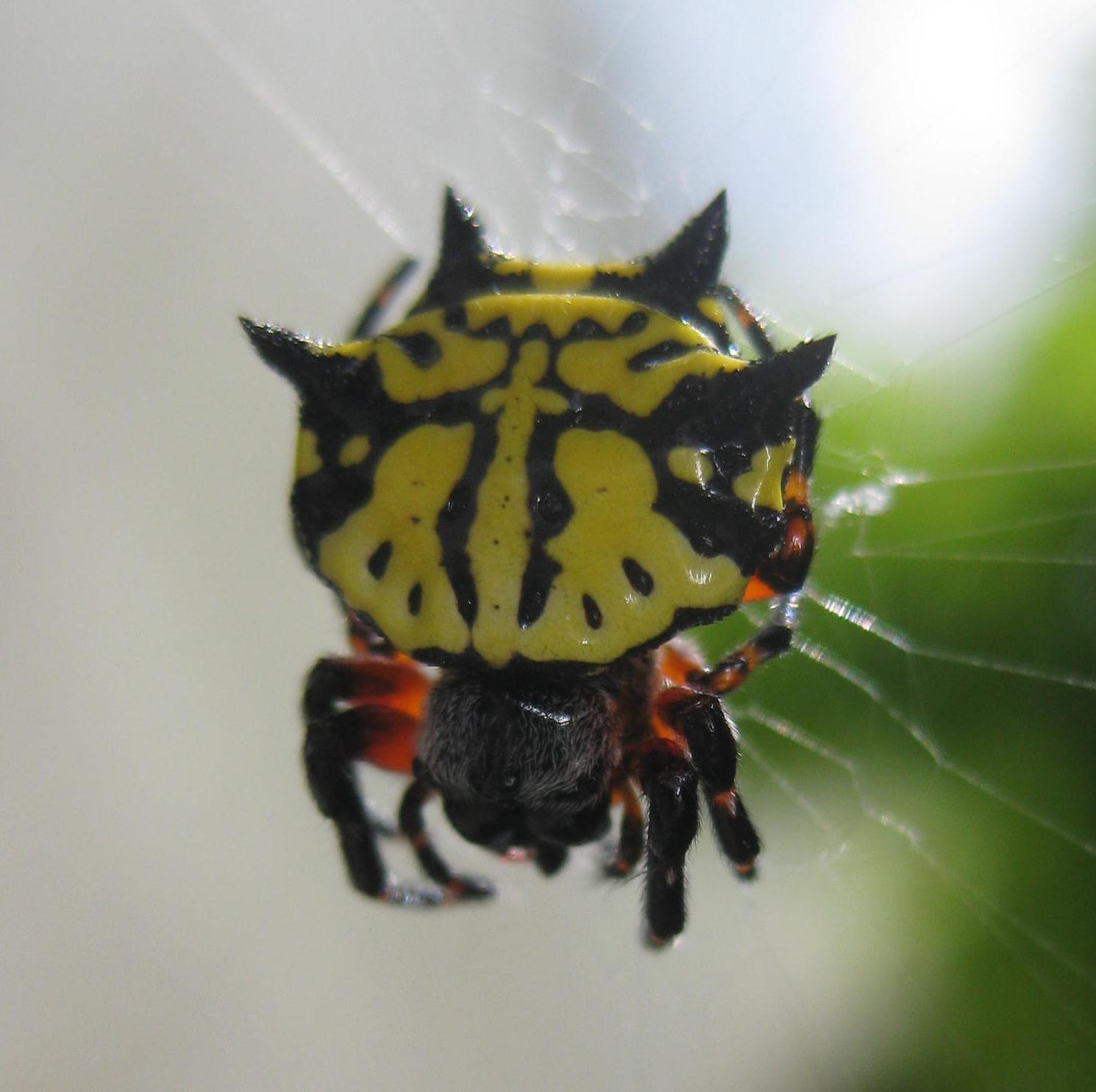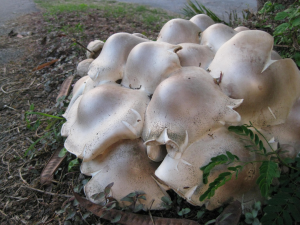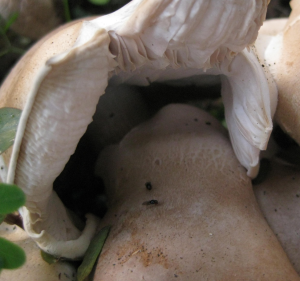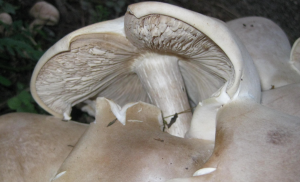During my first trip to the Philippine Islands, I flew straight to Butuan CIty to join Fe and William, who had been there a few days.
Just ran across a blog post by the Philippines Field representative from Seacology, about a Seacology project at Malhaio, Cebu, Philippines: A Covenant for Malhiao’s Mangroves .
Malhaio is located on the W. Coast of Cebu, facing Badian Island. The project involves and exchange of promises: Malhaio will implement a no-take zone of 73 hectares of mangroves, while Seacology will fund the building of a boardwalk and viewing deck to support the development of tourism. Jobs are involved, for enforcing the no-take zone.
Wednesday, October 12, 2011
Monday, August 1, 2011
A "Daddy Long Legs" in Texas
A close up also. This is not a spider. A wonderful blog had a discussion of these creatures.

[caption id="attachment_72" align="alignright" width="1024" caption="Phalangiid"]
 [/caption]
[/caption]
Monday, June 20, 2011
On a Saipan beach: Attack of the winged ants
We joined several friends at the beach yesterday afternoon. Our fun in the sun (and rain) was interrupted by a hoard of itching insects. Photographs show that they are ants.
[An email exchange over the course of a single day (June 21--coincidentally, the Summer Solstice) has led to something of an understanding about what this ant may be---or at least a general direction to look at. In the interest of accuracy, I am revising this post.]
Possibly they are Solenopsis geminata winged males. [Wrong on two points---they are not males, and they are not members of genus Solenpsis] They may belong to genus Hypoponera, and they are apparently reproductive females. An expert, Cas Vanderwoude, hasthis to say about this genus:
Their stings bothered some members of our Fathers' Day party at Paupau Beach, while others were not bitten at all.
 James Wetterer, who has taken on the task of cataloguing the ants of the Marianas, has forwarded an apparently unpublished list, with the following three members of genus Hypoponera listed:
James Wetterer, who has taken on the task of cataloguing the ants of the Marianas, has forwarded an apparently unpublished list, with the following three members of genus Hypoponera listed:

At the site http://ipm.ncsu.edu/AG369/notes/fire_ants.html, was found some fundamentals. We had wondered whether this was a fire ant, when it was black. With red legs. The workers of Solenopsis geminata are red. Writing about S. invictus, which (hopefully) we do NOT have on Saipan, the writers of that page made the following comments on the coloration of adults of various guilds:
I'm inclined to think that is what we have here.
The latter species has been noted as an invasive tramp species, elsewhere.
Aubrey Moore has contributed further:
Leading me to be even more cautious, Google teaches that in some ants, reproductive (winged) females may be dimorphic: Solenopsis spp. have macrogyne and microgyne populations, that make nuptial flights at different times of year.
Two days later, Fe is still suffering from intense itching: when someone touches one of the swollen bites (some of which are starting to develop white heads), she reports that these bites all over her body itch intensely. Mainly, on her back, back of the neck especially, and a couple on her arms. I was also attacked, but my reptilian skin seems to protect me better: only a couple of bites have swollen up. Fe says she was wearing perfume that day: she was clearly the most seriously affected, as she sat in the water for an hour or two, writhing in discomfort. They swarmed all over the back of my (red) shirt, and some others were bitten, and in at least one case, the bites subsided within a day.
This is clearly a seasonal event, and quite probably lunar. Winged ants of another species, a carpenter ant (Camponotus cf. chloroticus) swarmed out of the sill of the front door of our apartment on the same night. They are still bothering me two days later (just like their workers do, all the time.)
[An email exchange over the course of a single day (June 21--coincidentally, the Summer Solstice) has led to something of an understanding about what this ant may be---or at least a general direction to look at. In the interest of accuracy, I am revising this post.]
Whatever it is, it’s a Ponerine. All Ponerines have painful stings – some are reluctant to use it but others are more than happy to give you a jab or 2.
Their stings bothered some members of our Fathers' Day party at Paupau Beach, while others were not bitten at all.
 James Wetterer, who has taken on the task of cataloguing the ants of the Marianas, has forwarded an apparently unpublished list, with the following three members of genus Hypoponera listed:
James Wetterer, who has taken on the task of cataloguing the ants of the Marianas, has forwarded an apparently unpublished list, with the following three members of genus Hypoponera listed:
The red imported fire ant is the most common and troublesome species of ant in the southeastern United States. The worker (wingless female) is reddish or dark brown and may be large (6 mm) or small (3 mm). Winged males are black and have colorless to pale brown wing veins. Winged females are mostly light brown. Distinguishing among species of ants in the genus Solenopsis is difficult.
- Hypoponera confinis (Roger) Tinian, from specimens.
- Hypoponera pruinosa (Emery) Tinian and Papago, Saipan, both from specimens.
- Hypoponera punctatissima (Roger) Guam and Asuncion, from published records.
The latter species has been noted as an invasive tramp species, elsewhere.
Aubrey Moore has contributed further:
Were these ants stinging you? If so, they were females. The stinger is a modified ovipositor, so only females can sting.
Leading me to be even more cautious, Google teaches that in some ants, reproductive (winged) females may be dimorphic: Solenopsis spp. have macrogyne and microgyne populations, that make nuptial flights at different times of year.
Two days later, Fe is still suffering from intense itching: when someone touches one of the swollen bites (some of which are starting to develop white heads), she reports that these bites all over her body itch intensely. Mainly, on her back, back of the neck especially, and a couple on her arms. I was also attacked, but my reptilian skin seems to protect me better: only a couple of bites have swollen up. Fe says she was wearing perfume that day: she was clearly the most seriously affected, as she sat in the water for an hour or two, writhing in discomfort. They swarmed all over the back of my (red) shirt, and some others were bitten, and in at least one case, the bites subsided within a day.
This is clearly a seasonal event, and quite probably lunar. Winged ants of another species, a carpenter ant (Camponotus cf. chloroticus) swarmed out of the sill of the front door of our apartment on the same night. They are still bothering me two days later (just like their workers do, all the time.)
Tuesday, June 14, 2011
History of San Francisco Bay as Estuary
I've started digging around, trying to get a sense of our new home. I've lived in the Bay Area before, but never with a naturalist's eye. Now I stumble upon a consumately well written piece by none other than the great Joel Hedgepeth: San Francisco Bay: The Unsuspected Estuary, available here.
This paper, dated 1979, provides an appealing and broad coverage of the early history of naturalistic study of the Bay, and of the Bay's abuses at the hand of modern man. This goes with me on the plane. Here's one of the earlier pioneers, Grove Karl Gilbert:
[caption id="attachment_43" align="alignright" width="234" caption="From the PDF."] [/caption]
[/caption]
For nearly 200 years, Spanish navigators sailed the Manila galleons from Acapulco, northward past the unseen Golden Gate of San Francisco Bay, to Cape Mendocino whence they turned westward across the Pacific. It was not until 1769 that European explorers and "men of God" discovered the Bay, not from the sea by entering the Golden Gate, but from a hill to the south.
This paper, dated 1979, provides an appealing and broad coverage of the early history of naturalistic study of the Bay, and of the Bay's abuses at the hand of modern man. This goes with me on the plane. Here's one of the earlier pioneers, Grove Karl Gilbert:
[caption id="attachment_43" align="alignright" width="234" caption="From the PDF."]
 [/caption]
[/caption]
Sunday, April 3, 2011
Spiders
Two lucky shots of spiders, and two cool spiders. I haven't seen the crab spider before. I'd probably have noticed, as I am enamored of the crab spiders of Hawaii.

I read something this morning about Kleptoparasite spiders. This spider resembles one of them. Doggone it! That was one of the PDFs I didn't bother to save or take notes on. I'm using a new system to take notes and save bibliographic information from Google Scholar Searches, using Org-mode, BibTeX, and Cb2bib. Should've.

It seems noteworthy that the web of the silver bodied spider (the putative kleptoparasite) was butted right up against the web of the Crab Spider.
The webs were above a clothesline outside our apartment. Taken using a Canon SD1100 IS, with CHDK hacked firmware.

I read something this morning about Kleptoparasite spiders. This spider resembles one of them. Doggone it! That was one of the PDFs I didn't bother to save or take notes on. I'm using a new system to take notes and save bibliographic information from Google Scholar Searches, using Org-mode, BibTeX, and Cb2bib. Should've.

It seems noteworthy that the web of the silver bodied spider (the putative kleptoparasite) was butted right up against the web of the Crab Spider.
The webs were above a clothesline outside our apartment. Taken using a Canon SD1100 IS, with CHDK hacked firmware.
Wednesday, March 23, 2011
Mushroom Cluster
Friday, March 11, 2011
Great Cascadia Earthquake of 1700 M9.0
Yesterday's humongous earthquake in Japan is already listed in Wikipedia as the 7th biggest earthquake, based on its Magnitude of 8.9. Wow! I was drawn to #6, Great Cascadia Earthquake, as it was on the North American Continent---the home continent, with a Magnitude of 9.0.
The date and time of the Great Cascadia Earthquake in Oregon, Washington, and BC, was reconstructed by several methods. In particular, detailed Japanese descriptions/records of a Tsunami in the year 1700 made it possible, four hundred years later, to reconstruct the time of the Great Cascadia Earthquake. They arrived at an estimate of the evening (about 21:00 local time) of 26 January 1700. The paper is unavailable to download, as it is published in the journal Nature:
The Abstract:
A review is found in html:here.
Tree ring studies (including one by Yamaguchi et al. have also corroborated the 1700 date. And on Google Scholar one notes several studies of sediment layering in estuaries along the Oregon Coast.
I am particularly drawn to the paper by Ludwin et al.: an estimate--perhaps not as accurate as the above, but more fun to read---from pacific Northwest native stories: Downloadable here. From an analysis of Native Stories (accounts including oral remembrances of great grandchildren) they arrived at a close estimate, as referenced by Satake et al.:
The date and time of the Great Cascadia Earthquake in Oregon, Washington, and BC, was reconstructed by several methods. In particular, detailed Japanese descriptions/records of a Tsunami in the year 1700 made it possible, four hundred years later, to reconstruct the time of the Great Cascadia Earthquake. They arrived at an estimate of the evening (about 21:00 local time) of 26 January 1700. The paper is unavailable to download, as it is published in the journal Nature:
K Satake, K Shimazaki, Y Tsuji, K Ueda. Time and size of a giant earthquake in Cascadia inferred from Japanese tsunami records of January 1700. Nature 379, 246-249 (1996).
The Abstract:
GEOLOGICAL evidence shows that great earthquakes have occurred in the recent prehistoric past in the Cascadia subduction zone, off the Pacific coast of North America. The most recent event (or series of events) is dated at about 300 years ago, but the precise date and magnitude have not been determined. Geological investigations have not been able to distinguish a single giant earthquake from a series of great earthquakes occurring over a timespan of a decade or two4, although this information is important for the assessment of future hazard. We have found several tsunami records in Japan from AD 1700 with no indication of a local cause. Historical earthquake records and palaeoseismic evidence indicate the absence of a large earthquake in 1700 in South America, Alaska or Kamchatka, leaving Cascadia as the most likely source of this tsunami. The estimated time of the earthquake is the evening (about 21:00 local time) of 26 January 1700. The magnitude is estimated as 9 from the tsunami heights, in which case the earthquake ruptured the entire length of the Cascadia subduction zone2. These estimates are consistent with Native American legends that an earthquake occurred on a winter night.
A review is found in html:here.
Tree ring studies (including one by Yamaguchi et al. have also corroborated the 1700 date. And on Google Scholar one notes several studies of sediment layering in estuaries along the Oregon Coast.
I am particularly drawn to the paper by Ludwin et al.: an estimate--perhaps not as accurate as the above, but more fun to read---from pacific Northwest native stories: Downloadable here. From an analysis of Native Stories (accounts including oral remembrances of great grandchildren) they arrived at a close estimate, as referenced by Satake et al.:
The stories were told between 1860 and 1964. Figure 2 tabulates the accounts
and gives estimated date ranges. Date range minima and maxima are 1400 and 1825. All estimates span the interval between 1690 and 1715, and the average value of the mid-points of the date ranges is 1690. Discarding the earliest and latest midpoints yields an average midpoint date of 1701. This is remarkably consistent with the 1700 date of the most recent CSZ earthquake.
Here is a list of the historical 24 earthquakes of highest magnitude,
from Wikipedia. Notice that on the very day of the 7th Earthquake,
this was added to the Wikipedia record.
| Pos. | Date | Location | Name | Magnitude |
|---|---|---|---|---|
| 1 | May 22, 1960 | Valdivia, Chile | 1960 Valdivia earthquake | 9.5 |
| 2 | March 27, 1964 | Prince William Sound, USA | 1964 Alaska earthquake | 9.2 |
| 3 | December 26, 2004 | Sumatra, Indonesia | 2004 Indian Ocean earthquake | 9.1 |
| 4 | November 4, 1952 | Kamchatka, Russia (then USSR) | Kamchatka earthquakes | 9.0 1 |
| 5 | August 13, 1868 | Arica, Chile (then Peru) | 1868 Arica earthquake | 9.0 2 |
| 6 | January 26, 1700 | Pacific Ocean, Japan and USA and Canada | 1700 Cascadia earthquake | 9.03 |
| 7 | March 11, 2011 | Sendai, Japan | 2011 Sendai earthquake | 8.94 |
| 8 | February 27, 2010 | Maule, Chile | 2010 Chile earthquake | 8.8 |
| 9 | January 31, 1906 | Ecuador–Colombia | 1906 Ecuador-Colombia earthquake | 8.8 |
| 10 | November 25, 1833 | Sumatra, Indonesia | 1833 Sumatra earthquake | 8.8 |
| 11 | February 4, 1965 | Rat Islands, Alaska, USA | 1965 Rat Islands earthquake | 8.7 |
| 12 | November 1, 1755 | Lisbon, Portugal | 1755 Lisbon earthquake | 8.7 5 |
| 13 | July 8, 1730 | Valparaiso, Chile | 1730 Valparaiso earthquake | 8.7 6 |
| 14 | March 28, 2005 | Sumatra, Indonesia | 2005 Sumatra earthquake | 8.6 |
| 15 | March 9, 1957 | Andreanof Islands, Alaska, USA | 1957 Andreanof Islands earthquake | 8.6 |
| 16 | August 15, 1950 | Assam, India – Tibet, China | 1950 Medog earthquake | 8.6 |
| 17 | September 12, 2007 | Sumatra, Indonesia | September 2007 Sumatra earthquakes | 8.5 |
| 18 | October 13, 1963 | Kuril Islands, Russia (USSR) | 1963 Kuril Islands earthquake | 8.5 7 |
| 19 | February 1, 1938 | Banda Sea, Indonesia (Dutch East Indies) | 1938 Banda Sea earthquake | 8.5 |
| 20 | February 3, 1923 | Kamchatka, Russia (USSR) | Kamchatka earthquakes | 8.5 7 |
| 21 | November 11, 1922 | Atacama Region, Chile | 1922 Vallenar earthquake | 8.5 8 |
| 22 | May 24, 1751 | Concepción, Chile (Kingdom of Chile) | 1751 Concepción earthquake | 8.5 |
| 23 | October 20, 1687 | Lima, Peru (Viceroyalty of Peru) | 1687 Peru earthquake | 8.5 |
| 24 | December 16, 1575 | Valdivia, Chile (Kingdom of Chile) | 1575 Valdivia earthquake | 8.5 |
Tuesday, March 8, 2011
Erythrina variegata: calendar tree of the Pacific
Erythrina variegata and its congeners are widely used as calendrical markers in Pacific Island cultures. I have selected it, for now, as a header because it serves as an exemplar of certain research interests. This particular tree is located on the campus of Kagman High School. It is a tree worthy of a tale.
Despite its status as a cultural icon on numerous Pacific islands (7 I know about), on Saipan it is not a tree that is welcomed by farmers, because it serves as a reservoir for pest species. Aubrey Moore identified it as the larval host of Eudocima fullonia, a fruit-piercing moth. The Erythrina gall wasp is also a problem, as noted by Aubrey Moore of the University of Guam (pers. comm.): "the erythrina gall wasp invaded Hawaii where it has become a huge problem, killing their endimic erythrina and the tall wiliwili commonly used for windbreaks. This gall forming wasp has rapidly spread to other Pacific islands." He also states that this tree is not considered endemic to Pacific Islands.
That latter point is of interest, because the flame tree is honored by a festival in spring / early summer, on Saipan, yet it is not a native species.
Erythrina spp. are reported as caledrical markers in New Caledonia, Palau, Lamotrek (Caroline Islands), Pohnpei, Hawaii, Tahiti, and Samoa. Even more interesting, on most of these islands its flowering is associated with pelagic events, including shark hunting, drifting logs, and whaling. Klee, in his M.S. Thesis about Palauan time reckoning, mentioned that this tree is of special interest as a dry season blooming tree, and that it always blooms the same time every year, regardless of the weather.
[caption id="attachment_10" align="alignnone" width="420" caption="Erythrina variegata at Kagman High School, 18 February 2011."] [/caption]
[/caption]
The photo in the header was taken on February 18, 2011. This is a tale with many more twists and turns, as I intend to follow up upon.
Despite its status as a cultural icon on numerous Pacific islands (7 I know about), on Saipan it is not a tree that is welcomed by farmers, because it serves as a reservoir for pest species. Aubrey Moore identified it as the larval host of Eudocima fullonia, a fruit-piercing moth. The Erythrina gall wasp is also a problem, as noted by Aubrey Moore of the University of Guam (pers. comm.): "the erythrina gall wasp invaded Hawaii where it has become a huge problem, killing their endimic erythrina and the tall wiliwili commonly used for windbreaks. This gall forming wasp has rapidly spread to other Pacific islands." He also states that this tree is not considered endemic to Pacific Islands.
That latter point is of interest, because the flame tree is honored by a festival in spring / early summer, on Saipan, yet it is not a native species.
Erythrina spp. are reported as caledrical markers in New Caledonia, Palau, Lamotrek (Caroline Islands), Pohnpei, Hawaii, Tahiti, and Samoa. Even more interesting, on most of these islands its flowering is associated with pelagic events, including shark hunting, drifting logs, and whaling. Klee, in his M.S. Thesis about Palauan time reckoning, mentioned that this tree is of special interest as a dry season blooming tree, and that it always blooms the same time every year, regardless of the weather.
[caption id="attachment_10" align="alignnone" width="420" caption="Erythrina variegata at Kagman High School, 18 February 2011."]
 [/caption]
[/caption]The photo in the header was taken on February 18, 2011. This is a tale with many more twists and turns, as I intend to follow up upon.
Subscribe to:
Posts (Atom)



